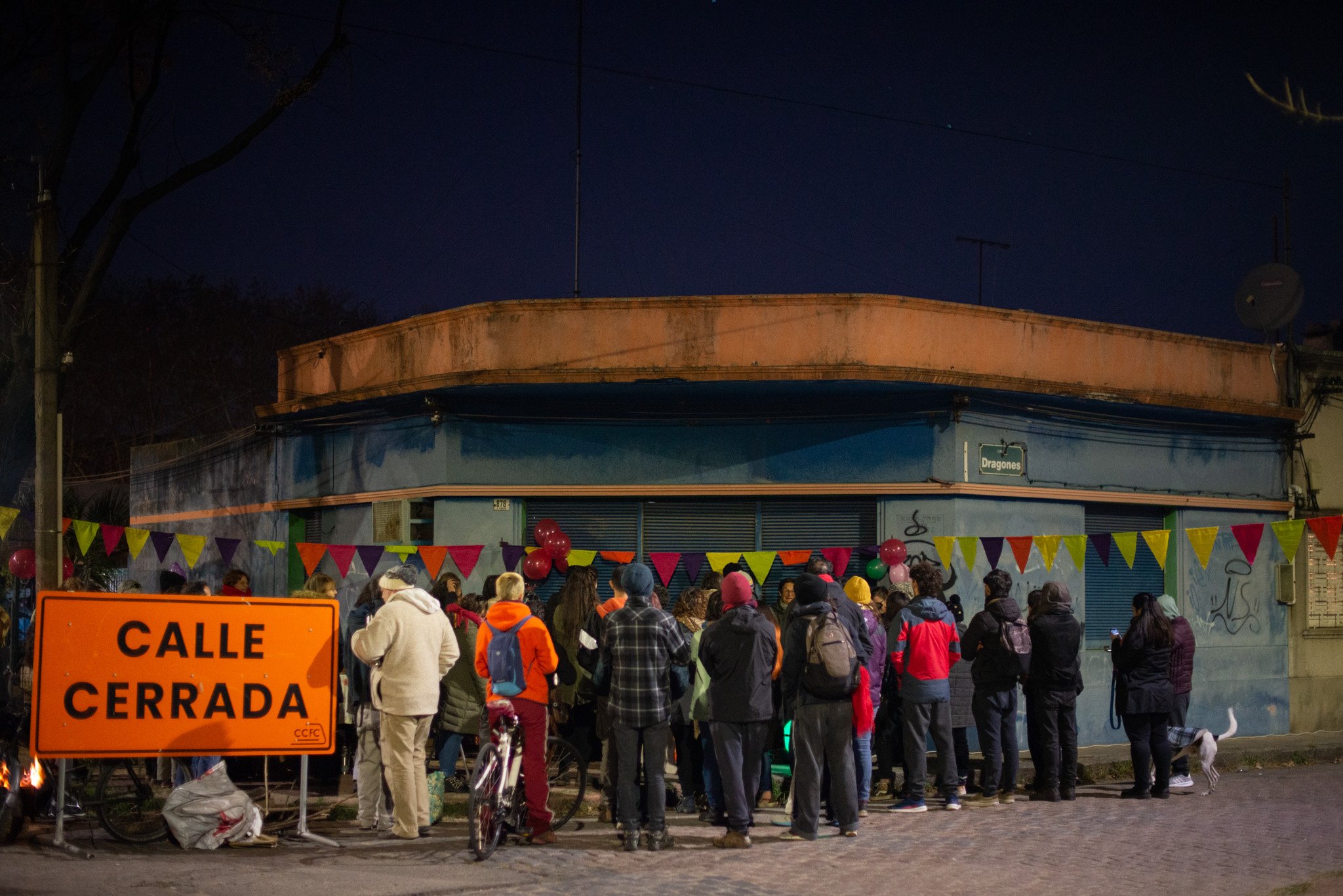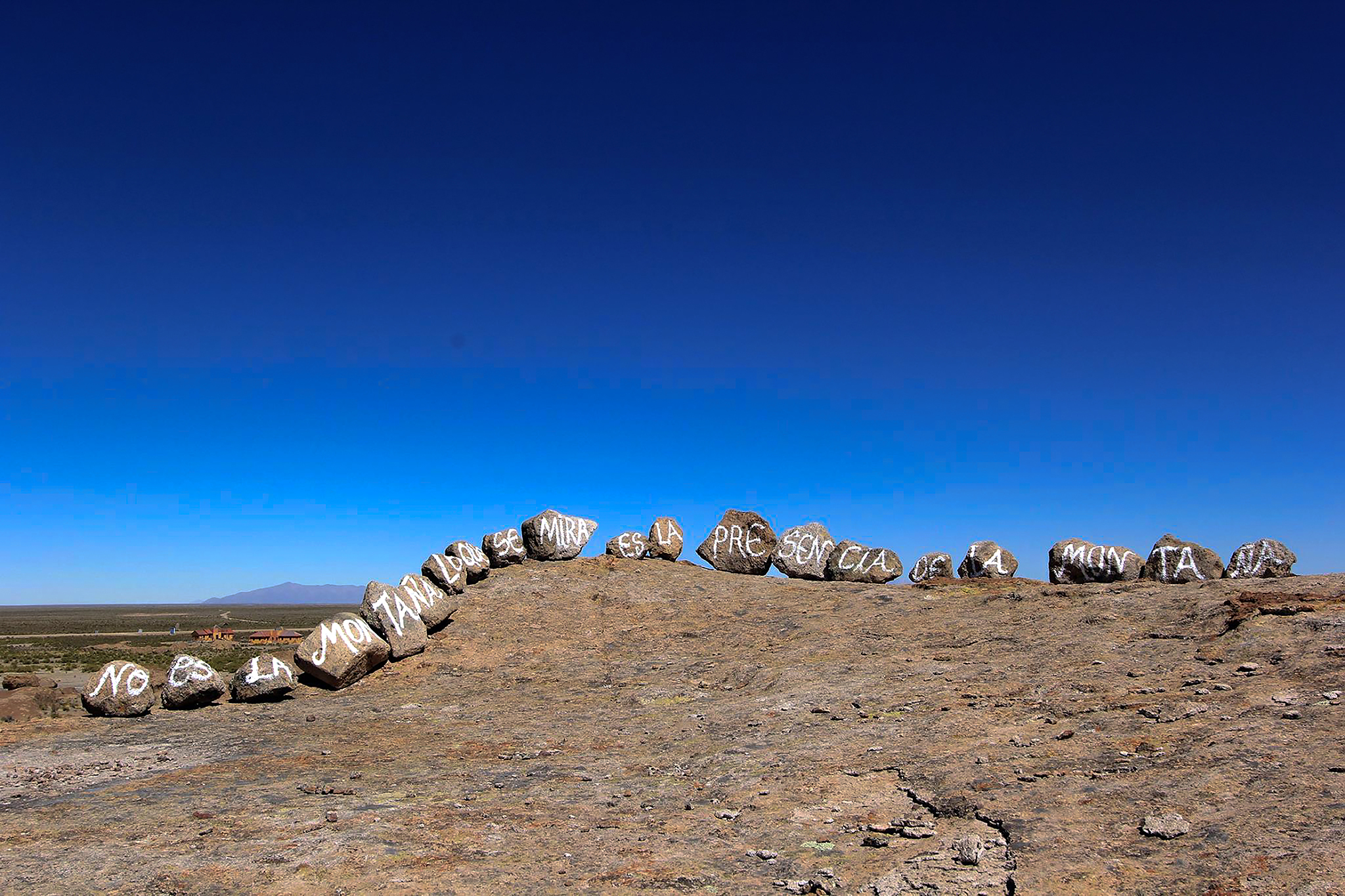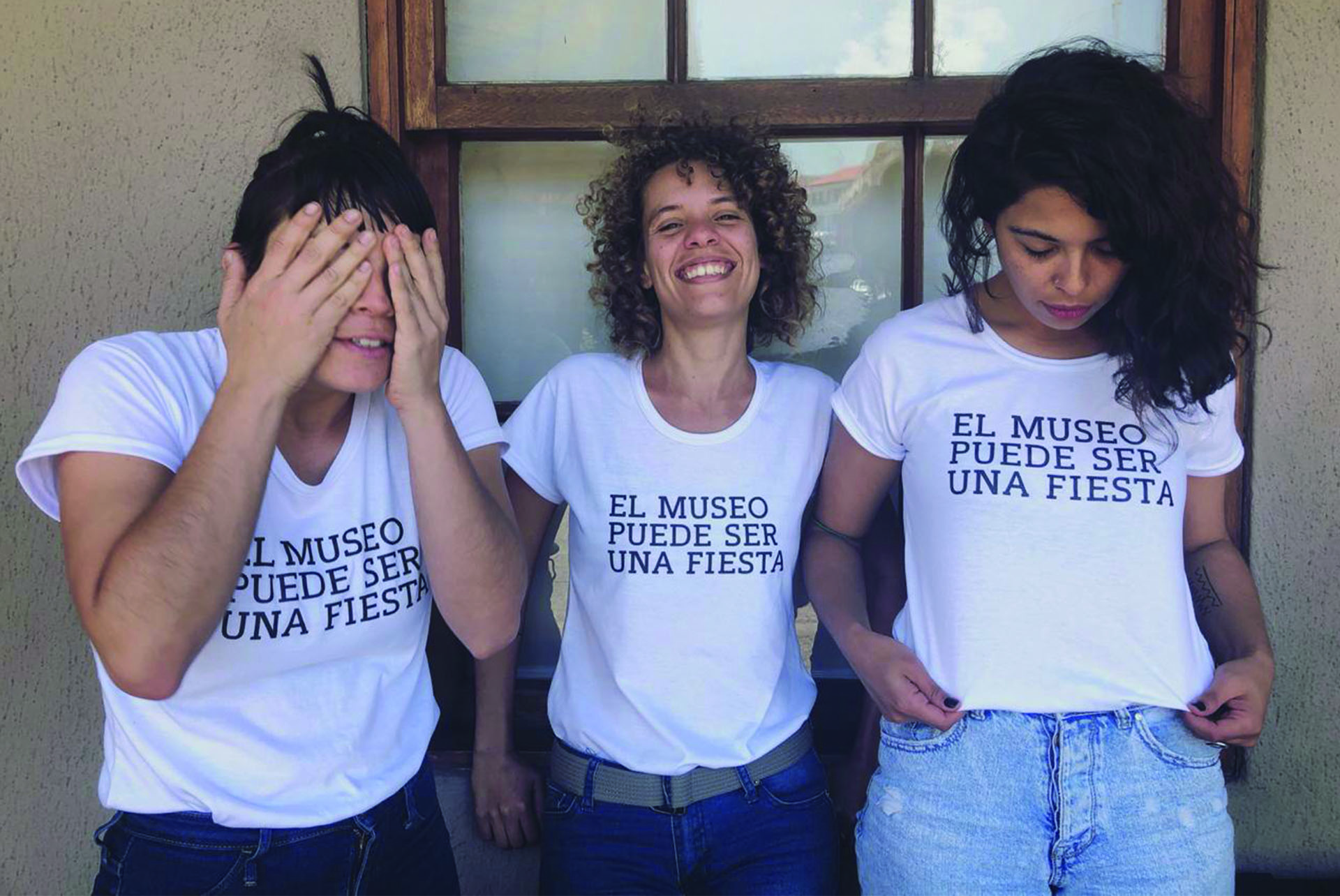Living Together and Doing In Common: Neighborhood Based Artistic Practices
07/15/2022
Ana Laura López de la Torre (Montevideo, Uruguay, 1969) is an artist, writer and educator. Her work is developed at a community level seeking to contribute to the defense and construction of common goods, stimulating the exercise of generosity, collaboration and exchange. For the Library of Practices, Ana shares with us the learning and processes she has cultivated from a rich experience around questions about the possibility of organization and forms of collective production around the intention of "doing in common."
Education
Schooling and Learning
I am the first generation in my family to have access to complete cycles of formal education. In my family environment the artistic forms were those of the popular tradition. My grandmother was an extraordinary oral storyteller; my mother, of great aesthetic sensibility, was a dressmaker, weaver and embroiderer; my father, originally a fisherman, became a confectioner when he migrated to Uruguay. My first contacts with art were through music, some activities at school, and encyclopedias that my mother bought in installments.
In public education spaces, art was something marginal and devalued. Motivated by some friends, at the age of 18 I enrolled in the School of Fine Arts and in the Universidad del Trabajo, in the Wood Carving course. At home there was a lot of pressure for me to study any of the liberal professions that my parents saw as a way of social and economic advancement. The National School of Fine Arts was a disappointment; it was a hippie environment that felt very authoritarian and machista. Then, when I was 19, I went to Europe. I first studied applied arts in Madrid, specializing in sculptural techniques in general and wood carving in particular. At the School of La Palma I had great technical teachers, from whom I learned the discipline of working in the workshop.
Then I went to London, where I managed to get into the master's program at Central St. Martins School of Art & Design. Anne Tallentire and Monica Ross were teachers who influenced me a lot, their pedagogical practice enabled experimentation and above all collaboration between students. They directed the Critical Fine Art Practice (CFAP) department, which promoted conceptual, intermedial and critical thinking. At CFAP I discovered the connection between the field of art and theory. In addition, they encouraged us to project ourselves as independent agents, to organize our own events, to submit to grants and calls, to create our own opportunities.
Then, in 2009, I was invited and awarded a scholarship to do a PhD at Chelsea College of Art & Design, where I did research on neighborhood-based art, which was where my head and heart was set: the question of organization and forms of collective production.
Teaching
Although I have been working as a teacher for more than a decade, I have no pedagogical training and, to be honest, I am not interested in teaching per se. In the late nineties I moved towards participatory and collaborative practices. Throughout my years in England, I undertook numerous projects commissioned by the education departments of Tate Modern, Tate Britain, the South London Gallery, Whitechapel Gallery, and various independent organizations; projects in community contexts, talks, interviews and articles on what was then the emerging institutional field of ‘socially engaged practices.’ In that relationship with the institutions I closely experienced the process of transformation of the conceptualization of mediation practices, reflected in the change of names of these departments (which changed to terms such as 'participation,' 'learning,’ 'public programs,’ etc.).
I do not have a strong interest in critical pedagogies, although I understand the conceptual and practical closeness to what I do; my relationship to the pedagogical has been more of a practical accident than an expressed intention. I understand my teaching practice at the university as another expression of my artistic practice, where learning is oriented on the intention of "doing in common."
Learning
I would like to highlight two English artists who have been great references for me: Ella Gibbs and Anna Best. In the late nineties, they welcomed me into their circle of connections, which extended affectively and generationally to experiences such as Action Space or the Artist Placement Group. In that informal network of artists, I developed and understood the contours of my practice from a mutual interest in collaborative work, in co-creation with all kinds of people, in different social and community contexts. We learned through trial and error, accompanying each other in our projects, critically examining our processes and motivations, particularly in relation to the institutionalization of ‘socially engaged practices,’ which was taking place at that time in the art world and in which we were involved.
Among the many things we did in that network, I highlight an intergenerational meeting in Brighton "SQAL/LP - Systems Questioning Art & Life / Live Practice," where we spent a week living and working together with artists from other generations such as Anne Bean, Alistar McLennan, Rolland Miller, Rob La Fesnais, Gustav Metzger, and Mine Kaylan. The intense discussions we had were very important to situate me in relation to the experimental practices of the sixties and seventies.
As part of my doctoral research, I studied popular artists such as Benito Quinquela Martín and the mosaicist Guillermo Vitale, whom I choose as antecedents of my practice because they are great and inspiring examples. Both worked outside the canon and developed neighborhood-based projects. In more general terms, my influences are linked to the exploration of art-life crossovers: Russian constructivism and productivism, unorthodox surrealism, situationism, punk, and popular culture in all its expressions.
Processes
Beginnings
The starting point can be a curiosity or a question, something I want or need to know more about. So I read and talk to different people, I work from the conviction that many agendas converge on the same interest, which are sometimes contradictory or in conflict. I try to keep all these visions in balance, even if only for a brief moment. When it comes to a commissioned project with a predetermined focus or context, I take time to find the intersection between what interests me and what is meaningful to that place or community. Walking, wandering, spending a lot of time in places is also very important. As I generally work in neighborhood or territorial contexts, being on the street without any specific objective or activity beyond observing and listening allows me to recognize places freely and without direction, to engage in spontaneous conversations and for my presence to become habitual in that environment, so that trust and complicity can emerge.
I try to delay as long as possible "having an idea" because I believe that these appear in the crossing and accumulation of thousands of small ideas that can come from anywhere. "Waiting for the air to thicken around the work of art," is a line I wrote that summarizes that moment of density of ideas and imaginaries, with which the title, premise, concept, or image that structures the project can be defined. For this, it is key to let time pass, not to rush or grab the first interesting idea that appears.
It is not a form of production that goes well with the project format or with institutional commissions that have other time frames; for that reason I have been moving away from this type of practices towards slower and iterative ways of doing things that, in my opinion, give rise to a poetics that is not very sensational but has a lot of affective and conceptual depth.

Questions
I am all in favor of improvisation. It is a powerful way to achieve or experience something previously unimagined. I really like the word 'nonsense' to express what I am looking for with my practice. In the initial stages of a project I have no idea where I'm going; chance encounters, marginal comments, accidents, coincidences carry me away. Openness to error, to accident, to contingency is fundamental, even if it means going backwards or abandoning a path I have taken.
I would say that the most significant change in my practice over time was the lengthening and opening of processes, which had practical implications, such as distancing myself from the formats of institutional promotion and circulation to focus my practice on my daily life, on the life of my neighborhood or in the context of the paid work I am doing at a given moment, as I am doing now when I am teaching full time.
Strategies
My practice is defined by a methodological approach rather than a thematic approach or one based on a specific language or medium. Generally speaking, there are three main moments in my processes. A first moment of recognition—of free exploration and of forming links ("friend-raising" as someone said). Generally, I join the activities that take place, whether they are established events or accompanying people in their daily chores. I think it is important to reverse the direction of participation, at least at some point in the process. If we review the field of participatory art, artists generally approach communities or places with a participatory proposal that is usually quite predefined. There is a risk that the role of the people ends up being that of qualified informants or free labor.
At a second moment, with an accumulation of trust and shared knowledge, I usually propose some activities inspired by existing interests or practices, but slightly decontextualized. For example, at I Wish I Knew how Does it Feel to Be Free, a residency at a private organization dedicated to the promotion of philanthropy for the arts, all the staff had two paid hours a month when they could leave the office to go see exhibitions, but they never used that benefit. I proposed scheduling those two hours for all staff at the same time. We went to London Town Hall to read the Ben Okri poem that adorns the spiral ramp that goes up to the top floor. It was a different experience that built on something that already existed.
In a third moment, I usually make a proposal that synthesizes all the previous work, something that I like to define as the point where my imagination touches that of others. Here we move on to work towards some closure or result, generally in live formats, multiple, or serialized reproduction to facilitate community distribution.


Procedures
Insofar as the process requires it, I integrate tools or procedures from other fields, which I freely bastardize. In each new project, I use the tools that can be most useful or helpful; I always make available any of my knowledge, if it is useful. I also enjoy inventing exercises, sometimes adapting or freely appropriating a work or proposal from other artists. In turn, my work is also nourished by collaboration with my peers in a mode of free association of ideas and actions that, like our friendship, extend over decades.
In any project I carry out, in one way or another, there is always the invitation to other artists to accompany me, to complete, observe, document, propose, or assume some role of their interest. I am also available to my peers, in the same capacity. This exchange adds a lot of methodological richness.
Dialogues
The process must have flexibility to allow different people to contribute in the way and to the extent that they want to or can; even if it becomes crazy at the production level. Another key is to involve people who generally do not know each other previously but have common interests, which can be enhanced in the encounter. I don't find it so interesting to work with collectives or communities that have an already established group identity or that have been institutionally segregated by age, gender or some other identity factor, because the expectations or preconceptions make it difficult for the nonsense to emerge. For example, I recently worked on a project in which I interacted with the radio amateurs of the Radio Club Uruguayo. Through the process, I connected them with sound artists working with radio art platforms and with Lorquian actors, all under the aegis of our common interest in the moon and in the defense of autonomy to communicate.
Another important thing is that people join in and contribute because they want to and not because they are forced to or because there is some form of direct or indirect material retribution. I would say that 80% of my artistic work is self-financed from this idea of freely sharing what we have. This gives power and energy to the processes and results.
Conversation is also something very structuring in all my processes, because it is where the possible scopes of the relationship and the work in common are instinctively recognized.
Works
In process
For a couple of years I’ve been trying to move a process entitled Enter the water, where I seek to give local continuity to projects on water issues that I did before in Brazil and Chile. I have already made some exploratory actions, started to develop links, but university teaching in pandemic does not allow me to move forward. So I am trying to reorient the process to contain it within my teaching practice, since I have many students who are also interested in environmental action. The idea is to accompany and guide younger artists to engage with local contexts and social action for the defense of natural resources.
I would also like to order and make public my 20-year archive of projects, works and processes in the places around the world where I have had the good fortune to work. It's a strange moment, I question all the time the relevance of continuing to work as we have been doing so far in the face of what is coming our way. I don't know what else to do, except to organize under any excuse, under whatever conditions are possible—to defend the presence, the body to body. I have seen in these years the emotional and physical devastation and dislocation of many people because of the separation and distraction measures imposed with the excuse of the pandemic. I am deeply concerned about what is happening to our ability to think and act collectively in this scenario. I can certainly see myself devoting time and energy to counteracting this in any way I can.
As a full professor of one of the workshops of the Faculty of Arts, I also coordinate some research groups. For 2022, we have funding for a seedbed focused on the study of community culture in Uruguay, and for a beautiful project, Bestiario de Malvin Norte. It is an interdisciplinary and collective exploration of the animal-human relationship in the neighborhood where I also live. In addition, we will work on the third edition of a training space called Art, Neighborhood and Social Action, which brings together the action of art students with neighbors in a typical Montevideo neighborhood context, and on a project with the Museum of Memory in a former clandestine detention center of the military dictatorship.
In Perspective
I believe that the least successful projects leave the greatest lessons to be learned, on which new proposals and ideas are built. Fortunately, we do art and not open-heart surgery, so mistakes are not so costly. Another important dimension in my learning process was when I got involved in projects with politically organized communities with a strong position towards the autonomy of their cultural and social capital. There I was questioned about my role, my positioning and many assumptions about the practices we take for granted in the art field.
Contexts
I am a great enthusiast and promoter of territorial contexts in artistic production. Now, the discussion on public space seems to me a jargon filtration from disciplines such as architecture and urbanism, on which we need to generate a sharper reflection from art. A contribution that seems important to me in this regard, arises from Denis Merklen's research Bibliotecas en llamas [Libraries on fire], in which she distinguishes the public space as a scene of conflict and the emblem thought from the idea of polis of the enlightened society. I share the interest in the space where public life takes place, or rather, life in common, but I feel closer to the idea of 'place,' which is important in Anglo-Saxon culture, or to that of 'territory,' so typical of our America.
I found my fondness for work rooted in neighborhood contexts through experiences. The first was a self-managed project with a group of artists who, through performance, intervention and installation, set out to question the process of gentrification that was beginning in our neighborhood (Brixton). There I carried out the action Complain, for You for Free, which consisted in spending a week in the street with a street stall, offering a free service of complaint letter writing. It was interesting the "traceability" of the effects of the action and the ramifications towards other proposals.
After several years of working on projects commissioned by institutions, I also grew tired of the time limits that this structure imposed on the processes, and the insistence that the results could somehow be turned around or the attention turned to the institutional context. In 2006 I decided not to accept any more commissions and to work in my neighborhood in an independent and self-financed way. Over time, I built a different kind of relationship with the institutions that were interested in my practice.
When I speak of neighborhoods or neighborhood contexts, it is important for me to make explicit that there exist multiple territorialities. Sometimes a block or a square can be a different universe from the one next to it, and I am interested in working from that complex and diverse texture. To think about how we can live together, live better, without losing those idiosyncrasies or absorbing them in a dominant identity, in clichés, or in a heroic story that ignores the shadows.

